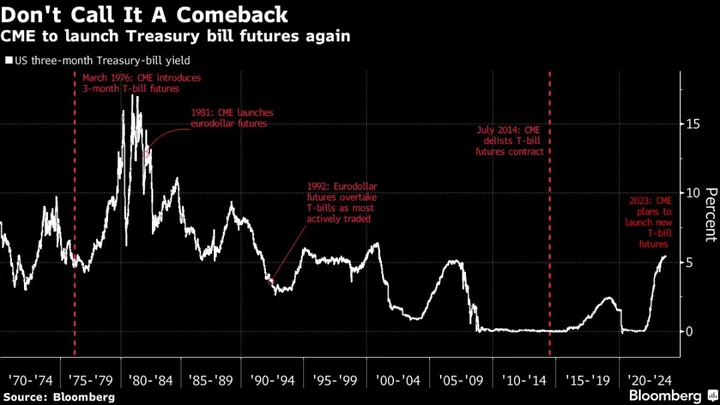CME Group Inc. will once again offer futures tied to three-month Treasury bills amid growing demand to hedge risks from surging supply and higher short-term interest rates.
Uncertainty over the Federal Reserve’s policy path and a flood of issuance to finance US growing deficits and rebuild the goverment’s cash buffer has sparked increased volatility in this corner of the market. The exchange plans to start trading futures tied to the Treasury’s benchmark three-month bills on Oct. 2, pending regulatory approval, according to a statement.
Since the government suspended the debt ceiling at the beginning of June, Treasury has issued more than $1 trillion of bills. While the market has so far digested the supply, concerns remain that funding markets will eventually struggle to absorb it, pushing rates on bills and overnight repurchase agreements — loans collateralized by Treasuries — even higher.
“The timing is right relative to net issuance, the higher level of interest rates, continued uncertainty as to where rates will go, continuing budget deficits, and the changing composition of the US marketable debt with regards to Treasury bills,” said Agha Mirza, CME Group global head of rates and OTC products.
Futures tied to 13-week US Treasury bills were first launched in March 1976 as the more than decade-long battle with inflation resulted in the Fed’s historic policy tightening. The contract was actively traded until the early 1990s when eurodollar futures linked to the London Interbank Offered Rate overtook activity in bill futures. CME finally delisted the contract in 2014.
The footprint of short-term debt is growing, with T-bills share of total US marketable securities ballooned to 19% from 16% before the debt ceiling was resolved. That’s near the top of the Treasury Borrowing Advisory Committee’s recommended range, though, the group said last month it’s comfortable with bill supply taking a larger share given investor demand.
Following the demise of Libor and eurodollar futures, the exchange is reviving the product to provide investors a way to take a position to offset potential market ructions. This version of the T-bills contract is designed similarly to the exchange’s contract for futures derived from Libor’s heir, the Secured Overnight Financing Rate, or SOFR. CME’s Mirza said customers have expressed interest in trading T-bill futures as a spread to SOFR.
“For listed futures people, eurodollars are gone, and SOFR-fed funds spread doesn’t move much,” said Rishi Mishra, an analyst at Futures First Canada. “Now with bills, this just gives us more options to find combinations so we can express a view.”

